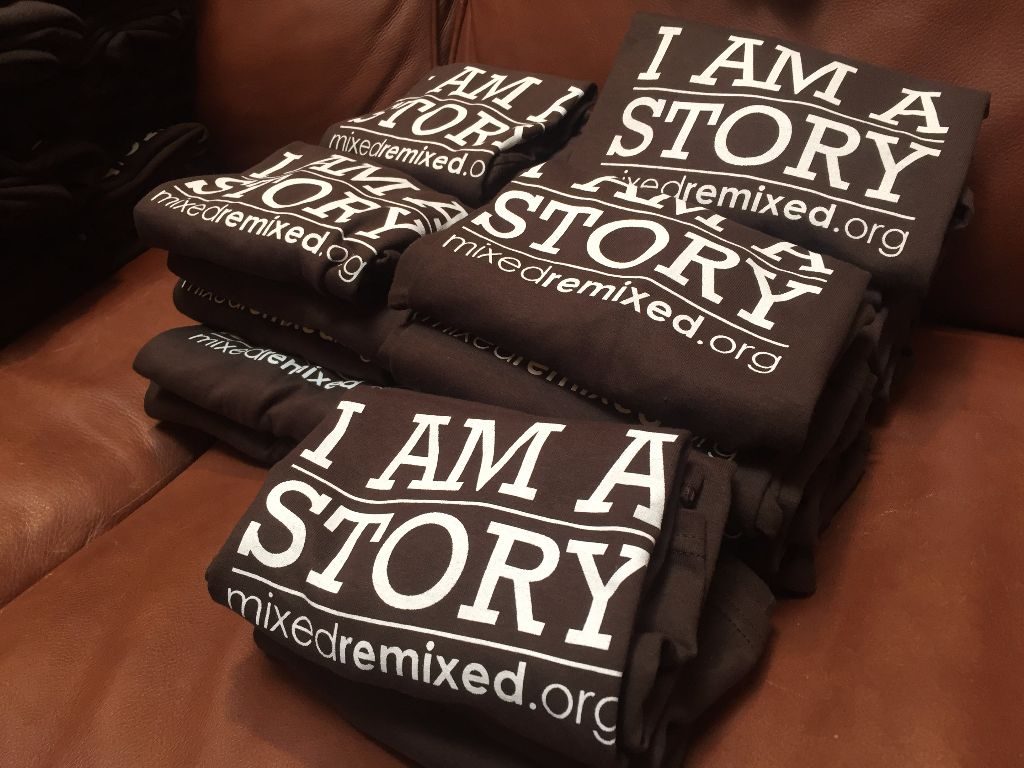 Part book reading part panel discussion, the Hapa Writers panel was among the highlights of the Mixed Remixed Festival. Panelists included authors Maria T. Allocco, Jackson Bliss, Leslie Li, Victoria Namkung, and Joy Stoffers, and was moderated by Mixed Remixed’s own Jamie Moore.
Part book reading part panel discussion, the Hapa Writers panel was among the highlights of the Mixed Remixed Festival. Panelists included authors Maria T. Allocco, Jackson Bliss, Leslie Li, Victoria Namkung, and Joy Stoffers, and was moderated by Mixed Remixed’s own Jamie Moore.
In addition to the panelists in the room, hapa artist and writer Kip Fulbeck was present in spirit: two writers on the panel (as well as this writer, and I suspect many present in the room) were introduced to the word “hapa” by way of Fulbeck’s book “Part Asian, 100% Hapa.”
“It opened up a whole new world for me and I really I started thinking about why I didn’t necessarily connect with all of the protagonists I was reading when I was growing up,” said Ms. Stoffers.
“I actually started crying,” said Mr. Bliss, telling the story of his stumbling upon “Part Asian, 100% Hapa” at a Tower Records in New York City. “I literally went home and, for the first time, started writing characters that were mixed race. And it was all because of the word.”
 The evolving vernacular used to describe us is surely a symptom of the the dearth of hapa representation in modern fiction, and why readers are so taken aback when introduced to a mixed race character. While touring for her debut novel, “Things We Tell Ourselves,” Ms. Namkung found that on many occasions readers asked her why her protagonist was mixed race. “I just feel like no one asked John Grisham or any white man why his characters are white and male,” she said, shedding light on a challenging reality: our voices must be heard. Ms. Namkung’s next book will also include a hapa character.
The evolving vernacular used to describe us is surely a symptom of the the dearth of hapa representation in modern fiction, and why readers are so taken aback when introduced to a mixed race character. While touring for her debut novel, “Things We Tell Ourselves,” Ms. Namkung found that on many occasions readers asked her why her protagonist was mixed race. “I just feel like no one asked John Grisham or any white man why his characters are white and male,” she said, shedding light on a challenging reality: our voices must be heard. Ms. Namkung’s next book will also include a hapa character.
This topic resonated with many of the panelists. “I wanted to reach out, through fiction, and put a voice to what I had felt was so silent,” described Ms. Stoffers. Mr. Bliss described a responsibility to tell the hapa story “because it [the hapa story] hasn’t been told enough, [any hapa story] becomes the monolith we use to evaluate other people who are hapa which is what happens when you don’t have enough representation.” The hapa story, he went on to say, need to be “written over and over and over again by millions of other hapa writers.”
In response to a question from the audience about how having a mixed race character affects character development, Ms. Li felt that a mixed race character “brings a complexity and also a higher degree of conflict. And I think when you’re writing a novel, when you’re writing anything, whether it’s nonfiction or fiction, the level of conflict will make the story a lot more interesting.”
 The use of the word “hapa” itself was a topic of conversation. Ms. Allocco described her complex and evolving relationship with the word. On the one hand, she felt the term to be Eurocentric, tending to exclude, for example, Afro- and Latino-Asians. On the other, there is a shared experience common to mixed Asians, and “hapa” is a word we can rally around. Ms. Allocco’s also briefly spoke about how she describes herself:
The use of the word “hapa” itself was a topic of conversation. Ms. Allocco described her complex and evolving relationship with the word. On the one hand, she felt the term to be Eurocentric, tending to exclude, for example, Afro- and Latino-Asians. On the other, there is a shared experience common to mixed Asians, and “hapa” is a word we can rally around. Ms. Allocco’s also briefly spoke about how she describes herself:
I’ve shifted away from the “half and half” type of language not just because, on a very basic level I’m whole, and I try to write from a place where I’m whole, but because my experience is so much more – it’s the opposite of half!
 What became clear during the course of the discussions is that the hapa identity is a complex topic, and the more the times the story is told, the more we will come to an understanding of what it means to be hapa in an increasingly diverse United States. And fiction is a potent tool when it comes to inserting new patterns of thinking into the collective conscious. We are all stories, after all.-Michael Maliner, Festival Blogger Twitter @plasticspoon
What became clear during the course of the discussions is that the hapa identity is a complex topic, and the more the times the story is told, the more we will come to an understanding of what it means to be hapa in an increasingly diverse United States. And fiction is a potent tool when it comes to inserting new patterns of thinking into the collective conscious. We are all stories, after all.-Michael Maliner, Festival Blogger Twitter @plasticspoon
This is one story in a series about the programs held at the Mixed Remixed Festival 2016. Please read through them all by searching our blog with “2016 Festival Re-Cap.”